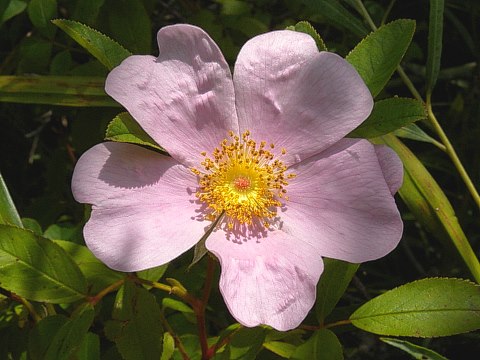
The upper stems occasionally produce either individual or small corymbs of 2-4 flowers on short branches. Individual flowers are 1½-3" across, consisting of 5 pale pink to rosy pink petals, 5 green sepals, a ring of many yellow stamens, and a flattened cluster of pistils that is yellow, pink, or reddish orange. The petals are oval-obcordate in shape, while the sepals are lanceolate and glandular-hairy. The pedicels of the flowers are also glandular-hairy. The blooming period occurs from early to late summer for about 1-2 months. The flowers have a sweet fragrance that is typical of roses. The flowers are replaced by globoid fruits (rose hips) about 1/3" (8 mm.) across that become red at maturity. The dried sepals on the fruits are initially widely spreading, but they are later deciduous and fall to the ground. The surface of the fruits is glandular-hairy, although it may become glabrous with age. The interior of each fruit is firm, fleshy, and slightly dry; it contains several bony seeds. The root system produces woody rhizomes. Vegetative colonies sometimes develop from the rhizomes.
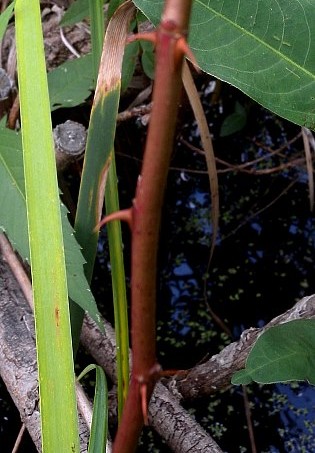
Cultivation: The preference is full or partial sun, wet to moist conditions, and an acidic soil containing peat, sand, or muck. Light shade is also tolerated, although fewer flowers will be produced. This shrub tolerates standing water quite well.
Range & Habitat: The native Swamp Rose is uncommon to occasional in most areas of Illinois, although it becomes rare in the western section of the state (see Distribution Map). Habitats consist of wet sand prairies, swamps and sandy swamps, soggy thickets, peaty bogs, gravelly seeps, marshes and sandy marshes, and ditches. In southern Illinois, Swamp Rose is found in Bald Cypress swamps. It is usually an indicator species of high quality wetlands.
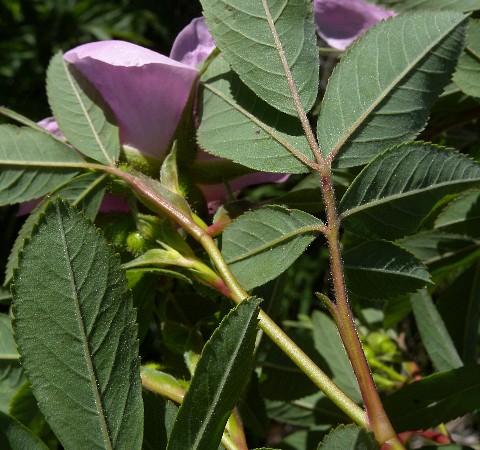
Faunal Associations: The flowers are cross-pollinated primarily by bumblebees and other long-tongued bees. Less effective pollinators include Halictid bees, Syrphid flies, tumbling flower beetles, and other beetles. Only pollen is available as a floral reward. Many insects feed on the foliage, flowers, and other parts of this and other roses. They include the caterpillars of Parasa indetermina (Stinging Rose Caterpillar) and other moths, the larvae of sawflies Endelomyia aethiops (Rose Slug) and Allantus cinctus (Curled Rose Sawfly), Typhlocyba rosae (Rose Leafhopper), Macrosiphum rosae (Rose Aphid) and other aphids, Aulacaspis rosae (Rose Scale), Plagiognathus rosicola (Rose Plant Bug), Brachypnoea puncticollis (Rose Leaf Beetle) and several Altica spp. (Flea Beetles), Merhynchites bicolor (Rose Curculio), Macrodactylus subspinosus (Rose Chafer), the larvae of Agrilus aurichalceus (Rose Stem Girdler), the larvae of Oberea perspicillata (Raspberry Cane Borer), the larvae of Rhagoletis basiolum (Rose Hip Maggot), Frankliniella tritici (Eastern Flower Thrips) and Heterothrips analis (Wild Rose Thrips), and other insects.
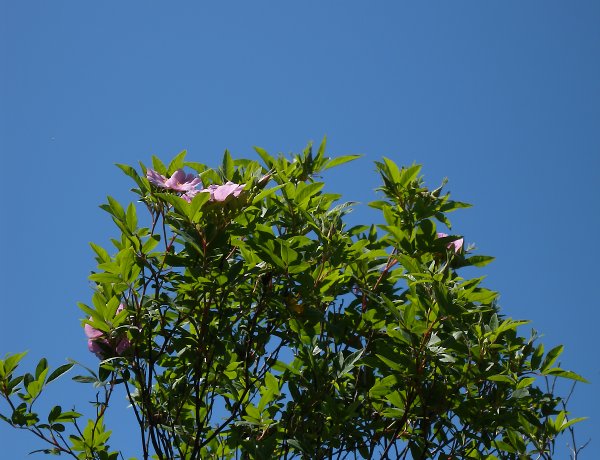
Some vertebrate animals also feed on roses. The fruit (rose hips) is eaten by some upland gamebirds (Ruffed Grouse, Prairie Chicken, etc.), songbirds (Cedar Waxwing, Swainson's Thrush, etc.), small rodents (White-Footed Mouse, Woodland Deer Mouse), and other mammals (Black Bear, Striped Skunk). White-Tailed Deer browse on the twigs and leaves, while Beavers use the woody stems as a food source and construction material for their dams and dens. Birds that construct nests in the taller roses include the Catbird, Northern Mockingbird, Brown Thrasher, Yellow Warbler, and Cardinal.
Photographic Location: A sandy marsh at the Indiana Dunes National Lakeshore in NW Indiana.
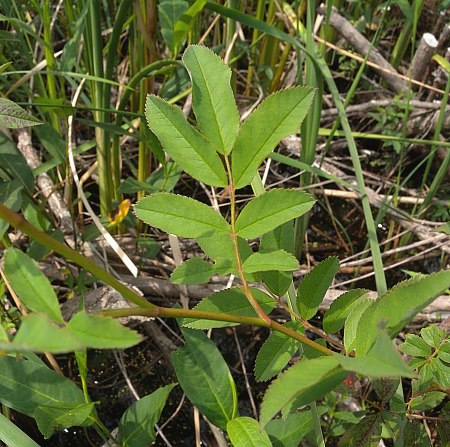
Comments: The Swamp Rose blooms somewhat later than other native roses. It produces attractive pink flowers that are relatively large in size and highly fragrant. It is also the only native or naturalized rose in Illinois that has an affinity for wetlands, rather than upland areas. Swamp Rose can be distinguished from similar species by a combination of characteristics: its tallness, stout curved prickles, revolute stipules with smooth margins, glandular-hairy sepals and pedicels, and compound leaves with 7 leaflets (usually, although some upper leaves have 5 leaflets). Swamp Rose has another characteristic that is highly unusual: the flattened disk of styles in the center of each flower is often pink or orange-red, rather than yellow. This creates an interesting contrast of colors between the styles and the surrounding stamens.